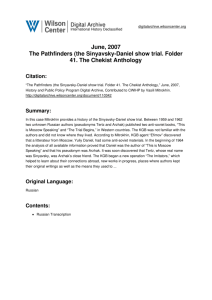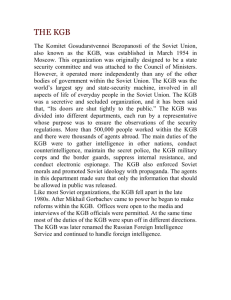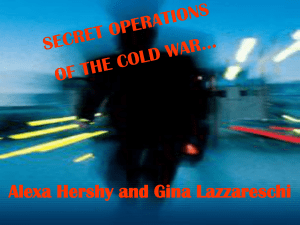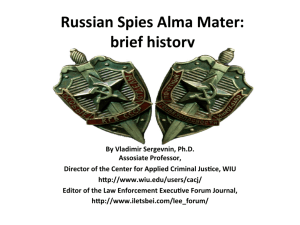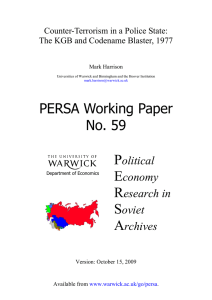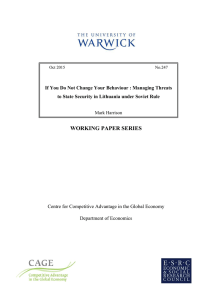WARWICK ECONOMIC RESEARCH PAPERS Counter-Terrorism in a Police State :
advertisement
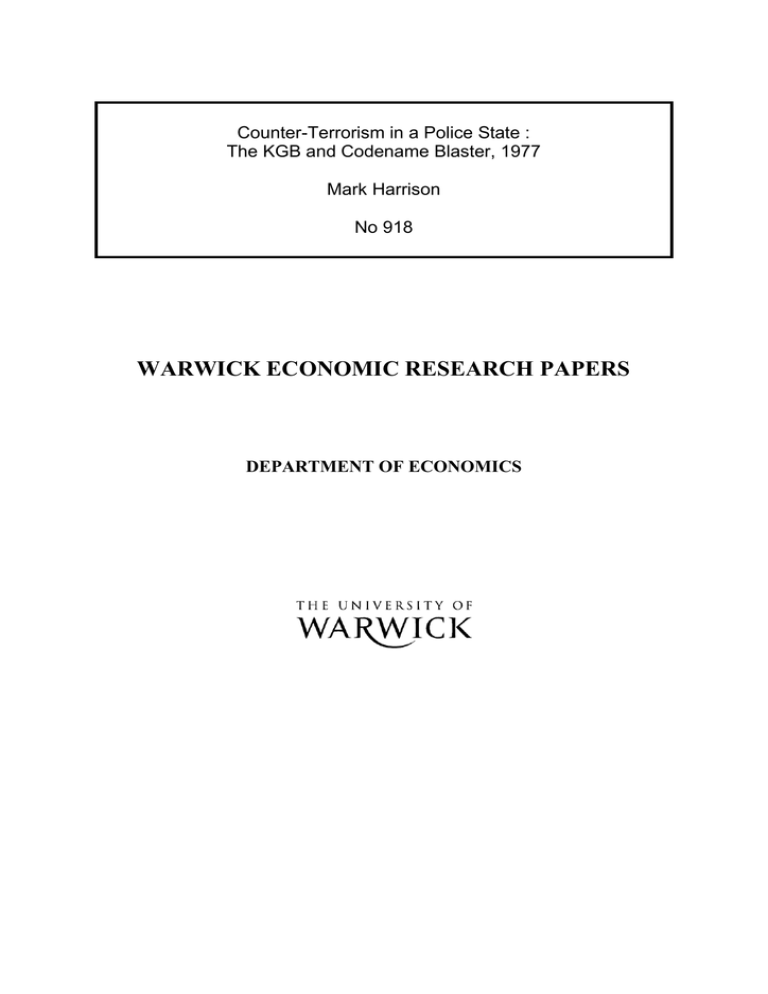
Counter-Terrorism in a Police State : The KGB and Codename Blaster, 1977 Mark Harrison No 918 WARWICK ECONOMIC RESEARCH PAPERS DEPARTMENT OF ECONOMICS Counter-Terrorism in a Police State: The KGB and Codename Blaster, 1977* Mark Harrison** Department of Economics, University of Warwick Centre for Russian and East European Studies, University of Birmingham Hoover Institution on War, Revolution, and Peace, Stanford University Abstract The paper provides a rare case study of terrorism and counter-terrorism within a closed society, carried out under a blanket of official secrecy. This case is unexpectedly revealing in what it tells us about terrorism, counterterrorism, and the relative strengths of open and closed societies. Documents from the archive of the Lithuania KGB show how the Soviet authorities managed the hunt for the perpetrators of bombing attacks carried out in Moscow in January 1977. Lithuania, a sensitive border region with a troubled history, was far distant from the epicenter of the conspiracy in Soviet Armenia, but the authorities did not know this beforehand, and made considerable efforts to establish or rule out a Lithuanian connection. It was a problem that the KGB, like other Soviet organizations, was vulnerable to boxchecking and other kinds of perfunctory working to the plan. The career concerns of regional KGB leaders appear to have countered this tendency. The paper evaluates the strengths and weaknesses of a counter-terrorist operation carried out under conditions of the intense secrecy that was normal in the Soviet police state. Keywords: Career Concerns, Homeland Security, Moral Hazard, Secrecy, Terrorism. JEL Codes: H56, K42, N44. * The research for this paper was carried out during the 2009 summer workshop of the Hoover Soviet Archives Research Project. I thank the University of Warwick for travel funding, the Hoover Institution for its support of the project, the staff of the Hoover Archive for assistance, Leonora Soroka and Amir Weiner for my introduction to the Hoover Archive’s holdings from the Lithuanian Special Archive, and Max Abrahms, Daron Açemoglu, Inga Arlauskaite, Eugenia Belova, Katya Drozdova, Paul Gregory, Saulius Grybkauskas, Peter Law, Leonora Soroka, and Ronald Suny for advice and comments. ** Mail: Department of Economics, University of Warwick, Coventry CV4 7AL, United Kingdom. Email: mark.harrison@warwick.ac.uk. First draft: October 15, 2009. Counter-Terrorism in a Police State: The KGB and Codename Blaster, 1977 The general pattern of modern terrorism is that terrorists tend to attack the citizens and interests of relatively richer, more open societies. Why this is so is not certain; it might be that terrorists object to the far-flung foreign interests that richer countries have and seek to protect, or that they expect to have greater impact where public opinion is freely informed, or both.1 Many studies of modern terrorism reflect the same bias, partly because richer, more open societies can provide scholars with more of the data necessary to build and analyze case studies. It is of interest to find a rare case of terrorism and counter-terrorism that documents the opposite: an outrage that was perpetrated within a closed society, immediately smothered by strict censorship, and investigated and brought to trial under a blanket of secrecy. This case is unexpectedly revealing about terrorism, counter-terrorism, and the relative strengths of open and closed societies. The case is based on files of the Lithuania KGB, recently acquired by the Hoover Institution at Stanford. These records are of general interest for two reasons. First, Lithuania was a front line of the Cold War: a strategically sensitive border state with a history of anti-Soviet nationalism, dense commercial and family links with foreigners, and an open coastline. Second, while access to the central KGB archives in Moscow remains virtually impossible, the Lithuania collection can be used as a window into the KGB and its role in Soviet politics and society. The story examined here is one of many that can now be told for the first time. The Crime In Moscow, Saturday January 8, 1977, was grey and frosty. It was two days after the Orthodox Christmas and three weeks after Leonid Brezhnev’s 70th birthday. At 5:33PM a bomb exploded on a packed train between the underground Izmailovo and May 1 stations. It was followed within 40 minutes by two more explosions. At 6:05PM a second bomb was detonated at food store no. 15 in the Bauman district. The third went off in the street between Red Square and Lubianka Square, the KGB headquarters, at 6:10PM. 1 Alan B. Krueger, What Makes a Terrorist: Economics and the Roots of Terrorism (Princeton University Press, 2007), p. 76-79, 129-131. 2 These attacks came out of the blue. No warning was given, and no one claimed responsibility. Two days later, on January 10, the Soviet news agency TASS issued an uninformative bulletin that mentioned only the subway blast. Without giving numbers, it recorded that “the injured received medical assistance.” In fact, the bombs were deadly: there were 44 casualties, including seven killed.2 In London the “journalist” and unofficial KGB spokesman Victor Louis suggested that Soviet dissidents could be to blame. On behalf of the liberal opposition the Nobel peace laureate and academician Andrei Sakharov immediately rejected the use of violence, adding that he could not rule out a KGB provocation.3 In the months that followed, the only visible police activity was persistent harassment of Sakharov and his circle.4 The Investigation Behind the scenes, the KGB mounted an intense nationwide hunt for the perpetrator, codenamed “Blaster” (Vzryvatel’ or Vzryvnik). Where might “Blaster” be found? At first they had no idea where to look, so they looked everywhere – including in Lithuania. There were few clues. A circular issued on behalf of Lithuania KGB chief Juozas Petkevičius, dated March 23, details the few facts that emerged from the crime scene.5 There were many witnesses to the attacks but no picture of 2 The death toll was admitted more than two years later, on February 8, 1979, in a letter from a citizen, D. V. Tiuzhin, that appeared in Izvestiia under the heading “Pozor zashchitnikami ubiits.” In the post-Soviet era many more details have appeared in the public sphere. An authoritative “inside” account seems to be that of Aleksei Stepanov, “Bomba v moskovskom metro,” Volzhskaia kommuna no. 18 (January 31, 2004) and no. 23 (February 7, 2004), available at http://old.samara.ru/paper/41/5070/91049/ and http://old.samara.ru/paper/41/5142/91314/ (retrieved on July 23, 2009). For English-language readers “1977 Moscow Bombings,” available at http://en.wikipedia.org/wiki/1977_Moscow_bombings (retrieved July 23, 2009) is an incomplete summary. 3 “Dr Sakharov Suspects Moscow Blast Plot,” The Times, January 15, 1977. 4 “Threat of Legal Action Against Dr Sakharov,” The Times, January 26, 1977. Sakharov discussed this and the aftermath in his memoirs, Vospominaniia (Part 2, chapter 26), first published in 1990. I used the on-line edition at http://www.sakharov-archive.ru/Raboty/V_Glava_2_26.htm (retrieved July 23, 2009). Memorial, the society that commemorates the victims of Soviet oppression, has reproduced some contemporary documents under the title “Khorosho zabytoe staroe” at http://www.bulletin.memo.ru/b14/13.htm (retrieved July 26, 2009). 5 Lietuvos ypatingasis archyvas (Lithuanian Special Archive), Lietuvos SSR Valstybės Saugumo Komitetas (Lithuanian Soviet Socialist Republic, 3 the perpetrators – only a vague description of a tall, broad-shouldered man in a brown overcoat with a beaver collar and fur hat, who pushed aside customers in the food store and rushed into the street. Of more practical use was forensic reconstruction of the explosive devices from metal fragments embedded in the surrounding structures and the bodies of victims. The piping that contained the subway bomb originated most likely in the Ukrainian city of Kharkov (today, Kharkiv). It had been welded using specialized equipment possibly associated with military metallurgy. Equally important was the recovery of artificial leather fabric from the bag used to conceal the bomb. The fabric was of a type manufactured in the district of Gorkii (Nizhnii Novgorod). After manufacture, however, the materials were widely distributed to dozens of plants across the Soviet Union – including Lithuania. Quality Assurance The March 23 circular did more than list facts. It also reported complaints about the detective work that was being done in Lithuania by the local KGB operatives and their agents. This proved to be the first of a litany that rose in volume until the search was concluded. The source of high-level anxiety was quality assurance. The KGB was already rounding up its “usual suspects” for questioning.6 Questions were being asked, but the answers were giving too few leads that could be passed back up the chain of command for further investigation. Regional KGB leaders worried that the rank-and-file were going through the formal motions of a manhunt, but no more than that. If the questions had been asked, the boxes could be checked, and the plan fulfilled, regardless of whether the answers were contributing to real progress. Unlike most Soviet civilian employees, KGB officers were highly selected for political loyalty and personal selfdiscipline, but they too could pretend to work, as in the joke: “They pretend to pay us, and we pretend to work.” In this episode, quality control seems to have been as much a problem for the KGB as for Soviet managers of industry and other economic enterprises. KGB leaders responded with a programme of enforcement and verification, following the template underlying just about any Soviet-era Committee of State Security) at the Hoover Institution, selected records, 1940-1985, fond K-1, opis 3, file 738, pages 8-15 (Lithuanian SSR Council of Ministers, KGB chairman Maj.-Gen. J. Petkevičius to chiefs of urban and district KGB departments and divisions, “V dopolnenie k No. 1-s ot 25 ianvaria 1977 goda o rozyske ‘Vzryvatelia’,” March 23, 1977). 6 In the movie Casablanca (1942), Vichy French police chief Renault orders his men: “Round up the usual suspects.” 4 administrative campaign.7 To all, they emphasized the atrocious nature and political importance of the original crime. Aiming at the rank-and-file, they reprofiled the “usual suspects” in greater detail than before, listing numerous markers that should draw suspicion and prompt deeper investigation. Aiming at middle KGB managers, they designed new reporting forms and demanded tighter compliance with deadlines, including accounting for negative results that would both eliminate suspects and demonstrate tasks completed. Thus, the KGB circular of March 23 listed for special attention: Lithuanian visitors and residents who could be shown to have visited Moscow over the critical period; released prisoners; any who had complained to the authorities without success about unsatisfactory living conditions, dismissal from work, refusal of an exit visa to travel abroad or emigrate, denial of access to secret documents (necessary for a vast range of white collar employments); and all with experience of or access to various specialized technologies and materials used to make the bomb (explosives, detonators, welding equipment) or carry it (artificial leather and personal accessories). A follow-up circular of July 21 issued a model questionnaire for KGB officers to distribute among auxiliaries, agents, informers, and reserve officers, detailing markers of suspicion.8 Listed for closer study were anyone previously convicted of crimes against the state, or expressing hostility to the Soviet system, or showing tolerance of anti-Soviet and nationalist views; dissatisfied complainants; dissidents and “Zionists”; anyone with a mental illness; and anyone with access to the materials or equipment involved in the bomb making. The July circular stressed that the KGB was not necessarily looking for just one person; the bomber could have worked alone, or one person could have made the bomb and another placed it. By late summer the KGB leadership was in a state of high nerves. On August 19 Lithuania KGB deputy chief Voroshilov circulated a wide-ranging critique of the work done so far.9 Not all officers, he observed, had grasped 7 Political campaigns may be found in every society but, in the context of a political and economic command system with only weak market incentives, such administrative mobilization campaigns were the Soviet regime’s most important instrument for redoubling efforts and reallocating resources. As Alec Nove remarked in The Soviet Economy (second edition, London: George Allen & Unwin, 1965), p. 305: “The repeated appearance of campaigns [is], to use the legal phrase, evidence of system.” 8 Hoover/LYA, K-1/3/738: 38-41 (Lithuania KGB operational group, “Primernaia pamiatka,” July 21, 1977). 9 Hoover/LYA, K-1/3/742: 136-138 (Lithuania KGB deputy chairman Maj.Gen. P. Voroshilov to chiefs of KGB departments and city and district 5 the “political importance” of the matter. He complained that the search was being carried out in a general and abstract way, with deficient reporting and missed deadlines. In particular, he said, too much emphasis had been placed on whether individual suspects could be placed physically in Moscow on the crucial date, at the expense of other lines of inquiry that might expose a conspiracy with not all present at the scene of the crime. As a result, there were still too few leads. Voroshilov demanded that from this point on the search must be given “first importance.” All investigations and agent contacts, however routine, including vetting and recruitment, must explicitly consider the possible identification of “Blaster”; all negative results must be documented. The Armenian Connection At about this time, an alert KGB officer at Tashkent airport made the first partial breakthrough. Among passengers with hand luggage, he spotted a bag similar in fabric and design to that forensically reconstructed from the Moscow bombings. It turned out to have been on sale in Erevan, the capital city of Soviet Armenia, from December 15, 1976, only three weeks before the terrorists struck in Moscow. There was an Armenian connection. Could there be an Armenian connection with Lithuania? On August 23, Voroshilov circulated a photograph of the bag.10 He ordered a new search to sweep up Lithuanian residents that had visited Armenia at the crucial time for work or recreation, or had had family or legal or illegal business contacts with Armenian residents, with a particular focus on any that might have bought bags in Erevan for personal use or resale. The scale of activity in Lithuania, a country of around three million people, is captured statistically in a summary of work done up to the end of August.11 Looking for “Blaster” were 198 agents (not including the KGB staff officers, called “operatives”), 126 “trusted persons,” 9 auxiliary workers, 17 reserve officers, and even two KGB residents abroad. From currently active cases, 98 persons had been screened. These were classified as follows: divisions, “O sostoianii raboy po delu ‘Vzryvnik’ i nekotorykh merakh po ee usileniiu,” August 19, 1977). 10 Hoover/LYA, K-1/3/742: 148-149 (Lithuania KGB acting chairman Maj.Gen. P. A. Voroshilov to chiefs of KGB departments and city and district departments and divisions, “Po delu ‘Vzryvnik’,” August 23, 1977). 11 Hoover/LYA, K-1/3/742: 141-147 (Lithuania KGB second administration, third department, first division chief Lt.-Col. Kazakov, “Spravka,” August 29, 1977). Most of the suspects enumerated In the document are also listed by family name. 6 • “Previously convicted of especially dangerous state crimes” • Currently under investigation and verification • “Extremist-inclined Zionists” • Interviewed in connection with “hostile expressions, negative attitudes to Soviet actuality, and other motives” • Dissatisfied complainants • Mentally ill with aggressive inclinations. • “Being processed according to primary documents in secret files” • Working or having worked with explosives • Known to have flown to Moscow on January 7 or 8 11 9 2 32 4 6 18 8 8 The report lists additional measures that testify to the increased intensity of the manhunt: for example, the Lithuania KGB agent network was currently searching for all persons that left work, moved house, or were imprisoned for trivial offenses after January 8; all who served in the army, worked with explosives, and were dishonourably discharged; and all who travelled to Armenia in December or January. Although the investigators had narrowed their lines of enquiry, after nine months they still had no idea who exactly they were looking for. In the end, the perpetrators gave themselves away. Late in October a routine police patrol interrupted one of them as he tried to prime and place a shrapnel bomb in the crowded waiting room of Moscow’s Kursk railway station. He walked away, leaving the bomb, which was recovered intact. With the bomb were personal effects intended for destruction. These helped quickly identify the terrorists. Taking the express train from Moscow, Zaven Bagdasarian was detained as he left it in Erevan. Another passenger, Akop Stepanian, was arrested shortly afterwards. These were the perpetrators but they did not look like the leaders. A short trail led to a third man, Stepan Zatikian. A house search found material evidence linking him directly to the January bombings.12 The Suspects At this stage, nothing was made public. News of the arrests spread quickly through secret KGB channels, reaching Vilnius in a few days.13 The three accused were males of similar age. Zatikian, a metalworker, married with two children, and Stepanian, a welder, single, were 31 and 30 respectively; Bagdasarian, an unemployed decorator, also single, was 23. 12 13 Stepanov, “Bomba,” Part 1. Hoover/LYA, K-1/3/742: 193 (Lithuania KGB chairman Maj.-Gen. J. Petkevičius to chiefs of KGB departments and urban and district divisions, “Po delu ‘Vzryvnik’,” November 17, 1977). 7 While Bagdasarian, described as “heavily influenced” by the first two, had a clean record, Zatikian and Stepanian were already known to the Armenia KGB. Zatikian had previously served four years in the Dubrava labour camp and Vladimir prison for taking part in an organized nationalist group, the “National Unification Party of Armenia.” The demand of this party was for a plebiscite on Armenia’s independence from the Soviet Union, and for unification with the Armenian lands in Turkey. Following his release, Zatikian tried to renounce his Soviet citizenship and claim asylum at the U.S. embassy in Moscow. As for Stepanian, the Armenia KGB had previously interviewed and warned him concerning his nationalist attitudes – clearly, without achieving the desired effect. 14 From left to right: Akop Stepanian, Stepan Zatikian, and Zaven Bagdasarian. Source: Hoover/LYA, K-1/3/742, following page 196. It seems likely the Armenia KGB had not previously identified either man as a suspect. The Memorial website records that the KGB took Zatikian in for questioning only weeks before his arrest, but did not raise his possible implication in bombs and terrorism during a twelve-hour interview.15 The roots of the affair lay clearly in Erevan. In Lithuania, however, there was still work to be done. At the end of November Petkevičius ordered a renewed search for evidence that the conspirators might have visited Lithuania or have had contacts there.16 Vladimir and Dubrava were far from 14 Hoover/LYA, K-1/3/742: 194-196 (Lithuania KGB chairman Maj.-Gen. J. Petkevičius to chiefs of KGB departments and urban and district divisions, November 30, 1977). Zatikian’s family status is reported in “Seriia terroristicheskikh aktov v Moskve (1977),” available at http://ru.wikipedia.org/wiki/Серия_террористических_актов_в_Москве_(1 977) (retrieved July 24, 2009). 15 “Khorosho zabytoe staroe.” 16 Hoover/LYA, K-1/3/742: 194-196. 8 Lithuania, but Lithuanian convicts had been confined in both places; had Zatikian acquired contacts among them? Given Lithuanians’ many foreign connections, could the conspirators have met with foreigners in Lithuania? Petkevičius also ordered an alert against further acts by possible accomplices not yet identified. On the same day, he joined with the Lithuanian minister of the interior to demand that the investigation so far be checked, audited, and rechecked if necessary.17 Not until July 1978 was the investigation in Lithuania finally closed down.18 The Verdict The men were tried in secret. According to subsequent reports, Bagdasarian admitted the charges in whole, and Stepanian in part. Zatikian, who had not been traced to the crime scenes, but was implicated by other evidence, denied everything, rejecting the authority of the court and the legitimacy of the “Jewish-Russian state.”19 The guilty verdict and death sentence were delivered on January 24, 1979. There was no appeal. The men were executed five days later. The evidence that convicted them, although extensively leaked, was never published. The documents available describe the evidence, assert the men’s guilt, and make it likely on a historian’s balance of probability, but do not prove it beyond reasonable doubt. The world heard nothing until January 31, 1979, when a short bulletin announced that three men had been tried in the USSR Supreme Court, condemned to death, and executed. Only Zatikian was named.20 At the time Sakharov protested that secret justice was no justice. He and other dissidents suffered a renewal of accusations, threats, and intimidation.21 Soviet Armenia remained quiet. The Armenian diaspora was far from quiet. Beyond Soviet frontiers, a wave of Armenian terrorism was starting to build. Between 1975 and 1988 17 Hoover/LYA, K-1/3/742: 197-199 (Lithuania KGB chairman Maj.-Gen. J. Petkevičius and Lithuania Minister of Internal Affairs Maj.-Gen. J. Mikalauskas to chiefs of KGB departments and urban and district divisions and chiefs of MVD departmental and divisional administrations, “Ob uluchshenii vzaimodeistviia i usilenii rabotu po rozysku ‘Vzryvnika’,” November 30 and December 2, 1977. 18 Hoover/LYA, K-1/3/746: 26 (Lithuania KGB chairman Maj.-Gen. J. Petkevičius to chiefs of KGB departments and urban and district divisions “O prekrashchenii raboty po delu ‘Vzryvnik’,”" July 5, 1978. 19 Stepanov, “Bomba,” Part 2. 20 “V Verkhovnom sude Soiuza SSR,” Izvestiia, January 31, 1979. 21 Sakharov, Vospominaniia. 9 two competing factions, the Armenian Secret Army for the Liberation of Armenia and the Justice Commandos of the Armenian Genocide, carried out 240 attacks in Europe, the Middle East, and North America, causing 577 casualties including 106 fatalities. Their professed aims were acknowledgement of the Armenian genocide of 1915 and reunification of the Armenian territories in Turkey and the Soviet Union. The great majority of their targets were Turkish subjects and interests; non-Turkish victims were mainly bystanders. The attacks were heavily concentrated in 1979 and the early 1980s, after which they diminished rapidly.22 Despite this activity, the Armenian factions in the West did not respond to the executions in Moscow; in fact, they generally did not attack Soviet interests at all. It seems likely that ASALA received covert Soviet support. This support was limited by the fact that both Moscow and Erevan had to balance the damage to Turkish and NATO interests against the risks of encouraging both Armenian and Turkic nationalism within the Soviet Union.23 Thus, this wider context is relevant without being directly significant. There is no reason to suppose that the Zatikian group was part of any wider conspiracy. Because the primary evidence remains secret, we remain unsure that the three accused men were properly convicted. Allowing for that, how well do they fit the general profile of a terrorist group? Specifically, if Armenian nationalists carried out the Moscow bombings, why did they not announce their existence, claim responsibility, or make demands of the Soviet regime? Surprisingly, such reticence is typical of modern terrorism. The Stanford political scientist Max Abrahms has observed that since 1968 “64 percent of worldwide terrorist attacks have been carried out by unknown perpetrators. Anonymous terrorism has been rising, with three out of four attacks going unclaimed since September 11, 2001.” Abrahms argues that this and other puzzles do not fit the standard model of rational agents using terrorism to achieve political ends. The puzzles are solved if we shift to another model: terrorists are often more easily understood as people who rationally use terrorist activity to achieve strong affective ties with other terrorists. 24 22 Laura Dugan, Julie Y. Huang, Gary LaFree, and Clark McCauley, “Sudden Desistance from Terrorism: The Armenian Secret Army for the Liberation of Armenia, and the Justice Commandos of the Armenian Genocide,” Dynamics of Asymmetric Conflict 1:3 (2008), pp. 231-149. 23 Michael M. Gunter, “Transnational Sources of Support for Armenian Terrorism,” Conflict Quarterly 5:4 (1985), pp. 31-52. 24 Max Abrahms, “What Terrorists Really Want: Terrorist Motives and Counterterrrorism Strategy,” International Security 32:4 (2008), p. 89. Abrahms write (p. 82): “The seven puzzles contradicting the strategic model 10 The Zatikian group fits this other model. Men in late youth, two of them single, the closest social bonds of Zatikian and his co-conspirators were with each other. One possible explanation of their conduct is that they conspired to kill others in order to cement their friendship. Seeking publicity would not have helped them to do this, so they did not seek it. Shirkers and Careerists Sakharov initially speculated that the KGB had organized, provoked, or exploited the bombings in order to go after preselected scapegoats such as democratic opponents of the Communist Party. What does the evidence show? The KGB certainly exploited the incident to detain, interrogate, and otherwise harass some dissident intellectuals. Eventually, however, these were released.25 In other ways the Lithuania KGB search looks genuine. Regional leaders mobilized the entire agent network for the widest possible search, and took action when they found signs that the search was becoming perfunctory. The Lithuania documents certainly start from the “usual suspects,” but they do not convey a plan to implicate them regardless of the evidence. On the contrary, regional KGB leaders seem to have been as eager to eliminate suspects as to find the guilty. Their apparent concern for reaching evidence-based conclusions is in marked contrast to the foot-dragging and lack of diligence that they identified amongst their own rank-and-file. This contrast could be explained in various ways; one way is a simple model of regional competition, in which the regional leaders were motivated to protect their reputations or careers. KGB leaders in any region, including Lithuania, faced several possibilities, some of which must have given rise to immense anxiety. The guilty would be found or not. If found, then where? They might be found locally, or somewhere else. Found by whom? By the local KGB, or by the KGB of the are (1) terrorist organizations do not achieve their stated political goals by attacking civilians; (2) terrorist organizations never use terrorism as a last resort and seldom seize opportunities to become productive nonviolent political parties; (3) terrorist organizations reflexively reject compromise proposals offering significant policy concessions by the target government; (4) terrorist organizations have protean political platforms; (5) terrorist organizations generally carry out anonymous attacks, precluding target countries from making policy concessions; (6) terrorist organizations with identical political platforms routinely attack each other more than their mutually professed enemy; and (7) terrorist organizations resist disbanding when they consistently fail to achieve their political platforms or when their stated political grievances have been resolved and hence are moot.” 25 Sakharov, Vospominaniia; Stepanov, “Bomba,” Part 1. 11 centre or some other region. The box below sets out the likely preferences of a regional KGB chief such as Lithuania’s Petkevičius: Guilty found: By the Lithuania KGB By Moscow or another regional KGB In Lithuania Second worst Worst In another region Best Second best It would be bad for Petkevičius if he found the guilty in Lithuania, because he would then have to explain how he had failed to stop an attack on the state. If they were found outside Lithuania, this would become someone else’s problem. In fact, it would advance Petkevičius most if his own men could provide the evidence that pointed outside Lithuania. But if the guilty were in fact inside Lithuania, Petkevičius could not not look for them because, in this case, it was absolutely imperative that his own men found them first. The very worst outcome would be for another region, or Moscow itself, to come into Lithuania and find them under his nose. If that happened, Petkevičius would be seen to have failed twice, first to prevent the crime and then to find the guilty. His career would be stuck at best, or might be over. The same career concerns would apply at lower levels of the KGB hierarchy, but much more weakly. Based on relative shares in the Soviet population, there was maybe one chance in 100 that the guilty might show up in Lithuania, but only one in 1,000 that they might show up in the Lithuanian city of Kaunas. The KGB field officer responsible for Kaunas could work this out for himself. Having done so, he might think twice before making the effort his superiors wanted. This can explain why the leaders had to browbeat the rank-and-file to secure the necessary diligence. The worst potential outcome for Petkevičius is the situation that the Armenia KGB actually faced in October 1977. As Moscow followed the trail to Erevan, it is said, Armenia party secretary Karen Demirchian and KGB chief Marius Iuzbash’ian went into vehement denial, rejecting the centre’s information and opposing its intervention. According to the same reports, their resistance collapsed only in the face of undeniable facts.26 26 Stepanov, “Bomba,” Part 2, citing Gen. Filipp Bobkov, head of the KGB fifth administration at the time. 12 Counter-Terrorism, Secrecy, and Justice Finally, we learn something about secrecy. There is a well established view that terrorists breathe what Margaret Thatcher called the “oxygen of publicity.”27 In this view, the Soviet authorities had the advantage of rigid censorship and a ban on unofficial media to deny terrorists the oxygen of publicity, and so prevent terrorist attacks. There may be a selection bias, however, in the belief that terrorists always stage their atrocities for maximum public impact, for these are by definition the events that we are more likely to hear about and remember. In the case of the Zatikian group, the advantage of censorship did not count for much. Censorship ensured that the original outrage received almost no publicity. But the Moscow bombers did not seek publicity and made no attempt to issue warnings, demands, or claims of responsibility. Lack of publicity did not stop them from trying to continue their campaign. Lack of publicity did prevent ordinary residents of Moscow from being aware of the threat they faced. If censorship achieved anything, it was the exclusion of copycat attacks in the years that followed. Secret justice was surely the greatest detriment of the Soviet style of counter-terrorism. Sakharov was right. Secret justice was no justice. In due course, this became a source of weakness of the Soviet police state. Could Armenians ever be sure, for example, of getting a fair trial in a Russian court? Such calculations did not cause but may well have increased the readiness of Armenians to embrace independence from the Soviet Union in 1991. 27 1985. “Thatcher Unfolds Strategy to Beat Hijack Terror,” The Times, July 16,
